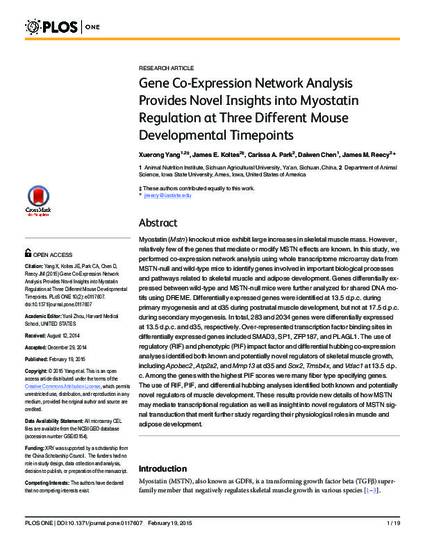
Myostatin (Mstn) knockout mice exhibit large increases in skeletal muscle mass. However, relatively few of the genes that mediate or modify MSTN effects are known. In this study, we performed co-expression network analysis using whole transcriptome microarray data from MSTN-null and wild-type mice to identify genes involved in important biological processes and pathways related to skeletal muscle and adipose development. Genes differentially expressed between wild-type and MSTN-null mice were further analyzed for shared DNA motifs using DREME. Differentially expressed genes were identified at 13.5 d.p.c. during primary myogenesis and at d35 during postnatal muscle development, but not at 17.5 d.p.c. during secondary myogenesis. In total, 283 and 2034 genes were differentially expressed at 13.5 d.p.c. and d35, respectively. Over-represented transcription factor binding sites in differentially expressed genes included SMAD3, SP1, ZFP187, and PLAGL1. The use of regulatory (RIF) and phenotypic (PIF) impact factor and differential hubbing co-expression analyses identified both known and potentially novel regulators of skeletal muscle growth, including Apobec2,Atp2a2, and Mmp13 at d35 and Sox2, Tmsb4x, and Vdac1 at 13.5 d.p.c. Among the genes with the highest PIF scores were many fiber type specifying genes. The use of RIF, PIF, and differential hubbing analyses identified both known and potentially novel regulators of muscle development. These results provide new details of how MSTN may mediate transcriptional regulation as well as insight into novel regulators of MSTN signal transduction that merit further study regarding their physiological roles in muscle and adipose development.
Available at: http://works.bepress.com/james_reecy/76/

This article is from PLoS One 10 (2015): e0117607, doi:10.1371/journal.pone.0117607. Posted with permission.